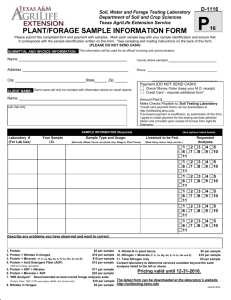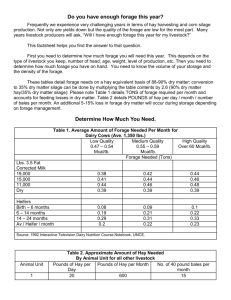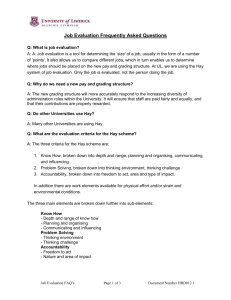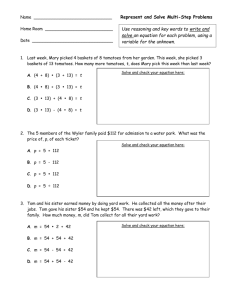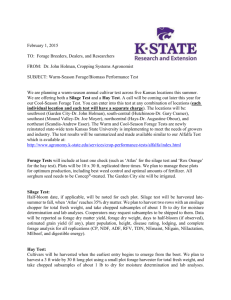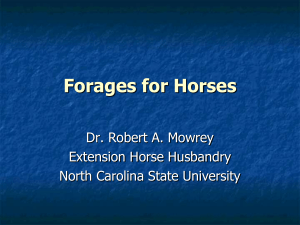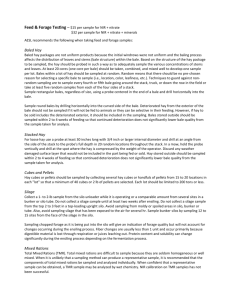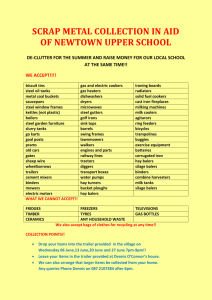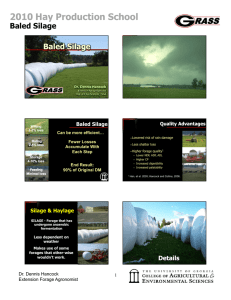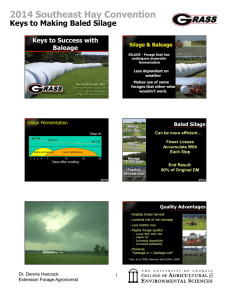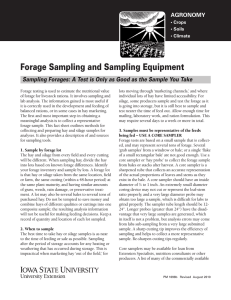Can I ensile rain affected hay?
advertisement
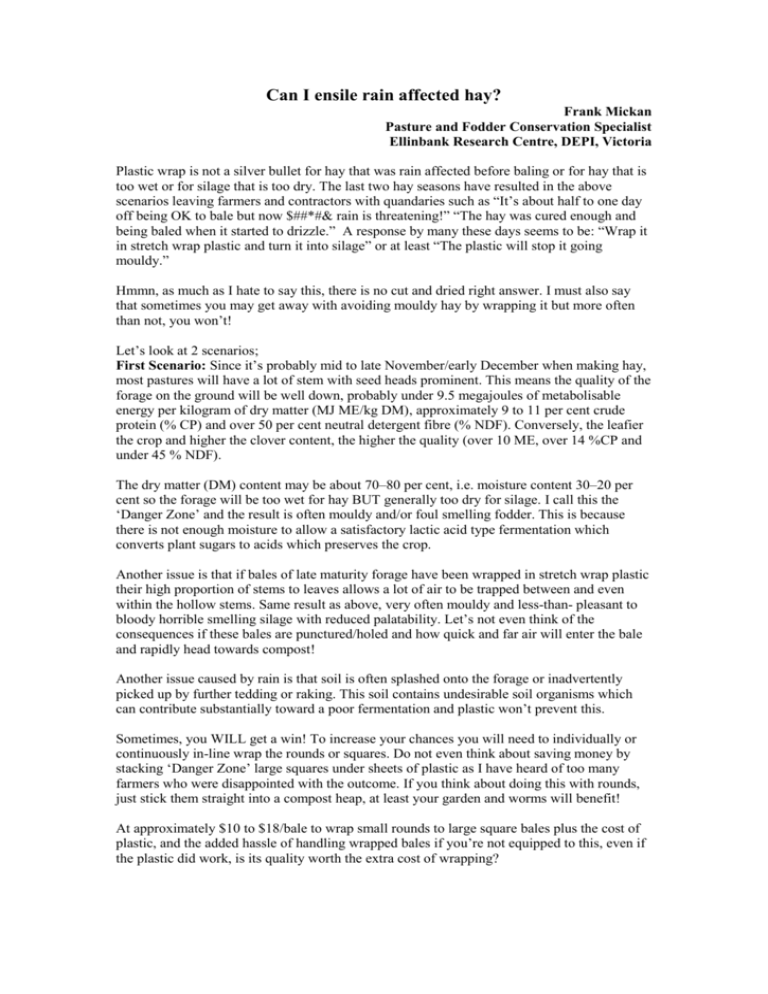
Can I ensile rain affected hay? Frank Mickan Pasture and Fodder Conservation Specialist Ellinbank Research Centre, DEPI, Victoria Plastic wrap is not a silver bullet for hay that was rain affected before baling or for hay that is too wet or for silage that is too dry. The last two hay seasons have resulted in the above scenarios leaving farmers and contractors with quandaries such as “It’s about half to one day off being OK to bale but now $##*#& rain is threatening!” “The hay was cured enough and being baled when it started to drizzle.” A response by many these days seems to be: “Wrap it in stretch wrap plastic and turn it into silage” or at least “The plastic will stop it going mouldy.” Hmmn, as much as I hate to say this, there is no cut and dried right answer. I must also say that sometimes you may get away with avoiding mouldy hay by wrapping it but more often than not, you won’t! Let’s look at 2 scenarios; First Scenario: Since it’s probably mid to late November/early December when making hay, most pastures will have a lot of stem with seed heads prominent. This means the quality of the forage on the ground will be well down, probably under 9.5 megajoules of metabolisable energy per kilogram of dry matter (MJ ME/kg DM), approximately 9 to 11 per cent crude protein (% CP) and over 50 per cent neutral detergent fibre (% NDF). Conversely, the leafier the crop and higher the clover content, the higher the quality (over 10 ME, over 14 %CP and under 45 % NDF). The dry matter (DM) content may be about 70–80 per cent, i.e. moisture content 30–20 per cent so the forage will be too wet for hay BUT generally too dry for silage. I call this the ‘Danger Zone’ and the result is often mouldy and/or foul smelling fodder. This is because there is not enough moisture to allow a satisfactory lactic acid type fermentation which converts plant sugars to acids which preserves the crop. Another issue is that if bales of late maturity forage have been wrapped in stretch wrap plastic their high proportion of stems to leaves allows a lot of air to be trapped between and even within the hollow stems. Same result as above, very often mouldy and less-than- pleasant to bloody horrible smelling silage with reduced palatability. Let’s not even think of the consequences if these bales are punctured/holed and how quick and far air will enter the bale and rapidly head towards compost! Another issue caused by rain is that soil is often splashed onto the forage or inadvertently picked up by further tedding or raking. This soil contains undesirable soil organisms which can contribute substantially toward a poor fermentation and plastic won’t prevent this. Sometimes, you WILL get a win! To increase your chances you will need to individually or continuously in-line wrap the rounds or squares. Do not even think about saving money by stacking ‘Danger Zone’ large squares under sheets of plastic as I have heard of too many farmers who were disappointed with the outcome. If you think about doing this with rounds, just stick them straight into a compost heap, at least your garden and worms will benefit! At approximately $10 to $18/bale to wrap small rounds to large square bales plus the cost of plastic, and the added hassle of handling wrapped bales if you’re not equipped to this, even if the plastic did work, is its quality worth the extra cost of wrapping? If the moisture content is only 3 to 5 or 6 per cent above the ideal baling moisture content, the best outcome might be to stick to baling it as hay, but use a reliable hay preservative. Always use hay preservatives at the correct rate, remembering wet hay is much heavier than cured hay, and ensure the preservative covers as much of the forage as possible. There are now several products with differing modes of action and you need to talk to reputable reps or farmers/contractors who have had success using various products. The DEPI Information Notes Series has a Note with much more information. Google ‘Hay preservatives’, or use this link: http://www.depi.vic.gov.au/agriculture-andfood/dairy/pastures-management/hay-preservatives Second Scenario: If the crop is pasture or lucerne and is medium to high quality, this more leaf and less stem, or thinner stems for the lucerne, the same story still applies as in the first scenario. However, there will be less air trapped in these more tightly packed bales and time you are starting with a higher quality base with plants containing more sugars for the bacteria to work on. The closer this forage is to silage dry matter and although there will still be a drop off in quality, the chances of a positive outcome are somewhat higher. With this scenario, still individually wrap and/or use a preservative but NO PROMISES! There is no magic answer to ‘is it worth wrapping that?’ and unfortunately Mother Nature has not been on the hay/silage maker’s side over recent year and this year? But, if the raw product was crappy to start with, then the end product will be too! As always your aim should be to aim to make milker quality fodder and if its not, then you need to remember this come feed out time. Figure 1. Hay baled too wet
